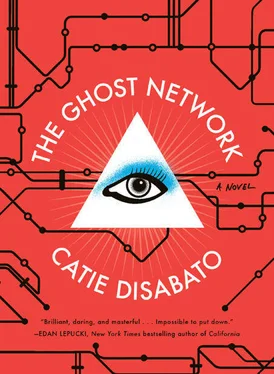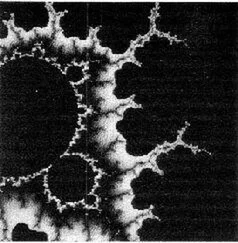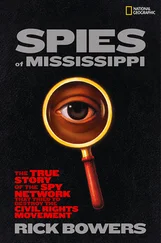Debord described how the dérive could be used to both destroy the modern city and build New Babylon, by discovering boundaries defined by the psychological feel of the city, rather than by arbitrary lines on a map. Debord wrote: “From a dérive point of view, cities have psychogeographical contours, with constant currents, fixed points and vortexes that strongly discourage entry into or exit from certain zones.”* The Situationists drifted in order to discover the “contours” that create boundaries, and they called the ethereal, intellectual tool they use while drifting to find those contours psychogeography . †
While Berliner studied New Babylon and The Ghost Network, Taer stayed with Molly’s notebook, trying to follow Molly’s logical paths and retrace her research steps from the days just before Molly disappeared. Though they were consuming different texts, Taer and Berliner’s research was linked, as demonstrated by a passage in Molly’s notebook that Taer often returned to, quoted from the opening of Debord’s Theory of Dérive . Debord was interested in a sociological study performed by Chombart de Lauwe in 1952, where de Lauwe strove to show that the average Parisian doesn’t live in a neighborhood so much as a small swath of the city determined by her own habits and preferences. Debord liked the description of a student living in the 16th arrondissement of Paris, whose movements de Lauwe tracked for a full year. Molly was also fascinated by this student, copying the details into her notebook: “Her itinerary forms a small triangle with no significant deviations, the three apexes of which are the School of Political Sciences, her residence and that of her piano teacher.” ‡
Taer copied this paragraph into her own journal and also asked Berliner to make a quick black-and-white screen print of the paragraph to hang above the bathtub in her room at the Urban Planning Committee headquarters. On the screen print, the quote was attributed to Debord, but in the bottom left-hand corner, Berliner included a version of the signature Molly gave him, SCREEN PRINT BY ANTOINE MONSON.
Taer’s fondness for the passage developed into something like a personal gospel. Although Debord was the author, the paragraph consists almost entirely of quotations from another man. Taer liked quotations, moments pulled from longer expression or ideas.
“The tone of a moment can be spoiled by its context,” Taer wrote. “A single moment creates a mood.”
Taer also latched on to the character of the female student — both a strangely vivid and maddeningly vague figure. Sometime in the late 1940s or 1950s, there was a girl, probably between the ages of eighteen and twenty-three, walking through Paris in a narrow triangle. From those bare bones, Taer created a person. Taer imagined she looked and dressed like the actress Carey Mulligan in the movie An Education , even though An Education takes place in the ’60s. Taer started calling the unnamed student Jenny, after Mulligan’s character. Taer wrote:
How shocking is the image of the piano teacher at the end after everything else? Suddenly, we know something about Jenny. She took piano lessons, often enough that the lessons formed one of the three apexes on her triangle. She was probably very good at piano. She was probably very passionate about her piano playing. She went to her piano teacher’s house more often than she went to the grocery store to buy food! She rarely went to the grocery store, her triangle tells us. Not to mention, the piano lessons imply a person in her life, a piano teacher. Another person.
After thinking about the piano teacher for a little while, I started looking back at the rest of the paragraph. She was a poli-sci student. Did she want to be a diplomat? In the early 1950s? Could she have even done that: run for office, be in politics? Or maybe she was the kind of girl that was looking for a husband that would become a Member of Parliament (MP) or something, did she want to live through him? She was living in the 16th arrondissement which probably means something about her, like the way living in Logan Square means you’re a different person than someone who lives in Wicker Park. Also, the way Jenny thought about her neighborhood, she built up some idea of the 16th arrondissement in her mind, and that helped create the neighborhood. It seems like a never-ending cycle of living and thinking about living and drifting into a precise triangle. It’s a kind of drifting, I think, because Jenny didn’t consider her life to be contained inside of one triangle until one man came along and showed her where she really was.
How did he diagram her movements? Was he a professor at her School of Political Sciences? Did he ask for paid volunteers? Was Jenny the only one, or did he diagram the movements of many students over the course of one year? How could he do this? Did he just follow her around all day? Did he ask her to document her own movements? Maybe he did and she didn’t report things — she went to the same student bar a lot and didn’t mention it because she often picked up men there and brought them back to her residence-apex. She would leave that out, wouldn’t she? It would be considered slutty. She’d want to present herself as this Student of Political Sciences and Student of Piano. She’d want to keep her dirty deeds to herself. Perhaps she was picking up women, not men. Ponytailed girls in blazers, also poli-sci students, named Joan, or Jeanne en français. Perhaps she masturbated at night to thoughts of someone recording her movements from the bar and home again, night after night with Jeanne. She imagined de Lauwe reading about her movements and she gasped, shocked and turned on at once, and that’s what made her cum, revealing herself to this older man and his stupid study.
Taer’s own life morphed into Jenny’s; the three apexes of her own triangle were Rainbo, where she still worked, the headquarters of the Urban Planning Committee, and the closest coffee shop. She went to the grocery store less, living off organic peeled baby carrots, clementines, red wine, and bacon.
Taer and Nix moved out of Taer’s apartment and into one of the unused rooms in the headquarters on Racine. With Berliner, they fell into a comfortable routine. Their days began when Berliner arrived at the Urban Planning Committee headquarters with three Americanos and three chocolate croissants in hand. Berliner and Taer opened their laptops and spent a few minutes checking the Internet for any news about Molly.
In the late morning, Berliner turned his attention to the vast quantities of information he, Ali, Peaches, and Molly had collected during the Urban Planning Committee’s most productive months. Taer spent her time with Molly’s notebook, or the assembled Ghost Network. Molly had actually thought of The Ghost Network as a three-part system. The first part was the collection of maps and blueprints Molly and Berliner had used to build the map. The second was the huge wall mural Berliner had painted at Molly’s behest. Berliner painted the two-story wall of Molly’s office using hundreds of shades of paint, one for each L train line, against a pearly, eggshell white. This copy of The Ghost Network was beautiful, but not practical.
The third version of The Ghost Network was digital. Molly’s programmer had designed the visual base of MollyMaps as a detailed road map of Chicago and the surrounding area, pilfered from Google Maps. Over the base, Molly added the train lines and stations by typing in the address of a station, or never-built station, and connecting the address to another address, where the next station would be, had been, or was. The digital version of The Ghost Network also contained a well-designed search function. The user could search for any train line or train station by name or location. MollyMaps also recorded every revision to the map in a searchable archive.
Читать дальше












